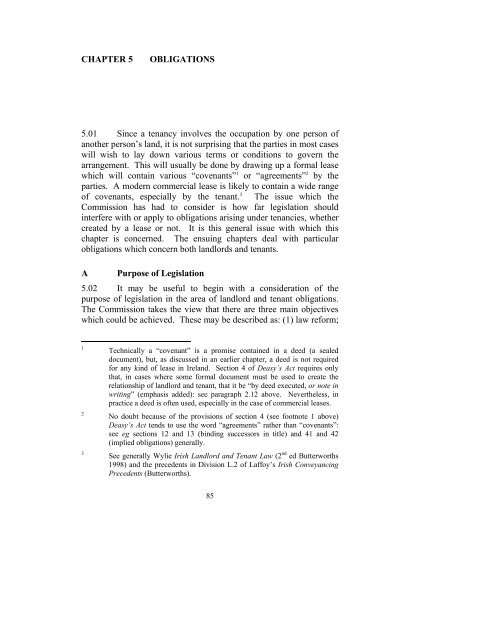Consultation Paper on the General Law of the Landlord and Tenant
Consultation Paper on the General Law of the Landlord and Tenant
Consultation Paper on the General Law of the Landlord and Tenant
Create successful ePaper yourself
Turn your PDF publications into a flip-book with our unique Google optimized e-Paper software.
CHAPTER 5OBLIGATIONS5.01 Since a tenancy involves <strong>the</strong> occupati<strong>on</strong> by <strong>on</strong>e pers<strong>on</strong> <strong>of</strong>ano<strong>the</strong>r pers<strong>on</strong>’s l<strong>and</strong>, it is not surprising that <strong>the</strong> parties in most caseswill wish to lay down various terms or c<strong>on</strong>diti<strong>on</strong>s to govern <strong>the</strong>arrangement. This will usually be d<strong>on</strong>e by drawing up a formal leasewhich will c<strong>on</strong>tain various “covenants” 1 or “agreements” 2 by <strong>the</strong>parties. A modern commercial lease is likely to c<strong>on</strong>tain a wide range<strong>of</strong> covenants, especially by <strong>the</strong> tenant. 3 The issue which <strong>the</strong>Commissi<strong>on</strong> has had to c<strong>on</strong>sider is how far legislati<strong>on</strong> shouldinterfere with or apply to obligati<strong>on</strong>s arising under tenancies, whe<strong>the</strong>rcreated by a lease or not. It is this general issue with which thischapter is c<strong>on</strong>cerned. The ensuing chapters deal with particularobligati<strong>on</strong>s which c<strong>on</strong>cern both l<strong>and</strong>lords <strong>and</strong> tenants.A Purpose <strong>of</strong> Legislati<strong>on</strong>5.02 It may be useful to begin with a c<strong>on</strong>siderati<strong>on</strong> <strong>of</strong> <strong>the</strong>purpose <strong>of</strong> legislati<strong>on</strong> in <strong>the</strong> area <strong>of</strong> l<strong>and</strong>lord <strong>and</strong> tenant obligati<strong>on</strong>s.The Commissi<strong>on</strong> takes <strong>the</strong> view that <strong>the</strong>re are three main objectiveswhich could be achieved. These may be described as: (1) law reform;123Technically a “covenant” is a promise c<strong>on</strong>tained in a deed (a sealeddocument), but, as discussed in an earlier chapter, a deed is not requiredfor any kind <strong>of</strong> lease in Irel<strong>and</strong>. Secti<strong>on</strong> 4 <strong>of</strong> Deasy’s Act requires <strong>on</strong>lythat, in cases where some formal document must be used to create <strong>the</strong>relati<strong>on</strong>ship <strong>of</strong> l<strong>and</strong>lord <strong>and</strong> tenant, that it be “by deed executed, or note inwriting” (emphasis added): see paragraph 2.12 above. Never<strong>the</strong>less, inpractice a deed is <strong>of</strong>ten used, especially in <strong>the</strong> case <strong>of</strong> commercial leases.No doubt because <strong>of</strong> <strong>the</strong> provisi<strong>on</strong>s <strong>of</strong> secti<strong>on</strong> 4 (see footnote 1 above)Deasy’s Act tends to use <strong>the</strong> word “agreements” ra<strong>the</strong>r than “covenants”:see eg secti<strong>on</strong>s 12 <strong>and</strong> 13 (binding successors in title) <strong>and</strong> 41 <strong>and</strong> 42(implied obligati<strong>on</strong>s) generally.See generally Wylie Irish <strong>L<strong>and</strong>lord</strong> <strong>and</strong> <strong>Tenant</strong> <strong>Law</strong> (2 nd ed Butterworths1998) <strong>and</strong> <strong>the</strong> precedents in Divisi<strong>on</strong> L.2 <strong>of</strong> Laffoy’s Irish C<strong>on</strong>veyancingPrecedents (Butterworths).85
















